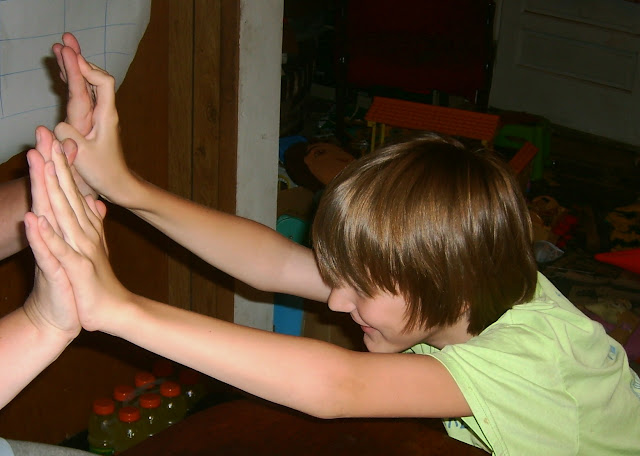Building Lab, Part I: Compression, Tension and Torsion in Building Materials

Compression (Squeezing)
Compression is a force that squeezes a material together, which tends to make the material become shorter. The lower columns of a skyscraper, for example, are compressed by the heavy weight above them.
Tension (Stretching)
Tension is a force that stretches a material apart which tends to make the material become longer. For example, the cables in a suspension bridge have the weight of the roadway and all the cars traveling on it pulling on them, creating tension on the cables.
Bending
When a straight material becomes curved, one side squeezes together and the other side stretches apart. This action is called bending. The top side of the metal bar is pulled apart in tension, and the bottom side is squeezed together in compression. This combination of opposite forces produces an action called bending.
Shear (Sliding)
Shear is a force that causes parts of a material to slide past one another in opposite directions. For example, during an earthquake, parts of a roadway can shear or slide in opposite directions.
Torsion (Twisting)
Torsion is an action that twists a material. For example, a bridge can twist violently in strong winds and collapse. The twisting force is called torsion.
Builders Need to Know Their Materials
Different materials have varying abilities to withstand compression, tension, and torsion. Students can get a chance to test materials around the house to learn about these terms and about the building materials. Send your students on a scavenger hunt to find building materials such as yarn, popsicle sticks, pipe cleaners, clay, sponges, erasers, rubber bands, paper-towel tubes, pencils, cardboard, aluminum foil, drinking straws, tiles, or cloth.
Testing the Materials
Students can perform three tests on the materials gathered to determine the tension, compression and torsion abilities of each of the samples.
Tension: To test the material in tension, pull on it or tug it from both ends.
Compression: To test the material in compression, push it together from both ends.
Torsion: To test the material in torsion, twist the two ends in different directions.
Demonstrate how to test the materials by choosing one and tug, push and twist on the sample to test tension, compression and torsion. For example, using a rope to demonstrate the tests, have two kids tug on the ends of a rope (tension), then push the ends together (compression), and finally twist the ends of the rope (torsion). They should find that the rope is strong in tension but weak in compression and torsion.

Now have each student pick a few items from what they have gathered and predict which ones will be strongest in tension, which in compression and which in torsion.
Now, have them test the materials by performing the same tests which you had demonstrated on them. Students will have to help each other in pairs to accomplish this. Then they should record their findings, ranking the materials from 1-4 (1 Very weak! It crumples or breaks with hardly any force. 2 Only fair—it can't withstand much force. 3 Pretty good—it takes a lot of force to break it. 4 Super strong! We can't break it.) They should find that the materials that are strongest in tension: are the string, yarn, pipe cleaner, popsicle stick, ceramic tile, cardboard, drinking straw, cloth, rubber band (strong but very flexible), rubber eraser, paper-towel tubes and the pencil. The materials that are strongest in compression are the popsicle stick, clay (limited), ceramic tile, rubber eraser, paper-towel tubes (limited) and the pencil. The materials that are strongest in torsion are the ceramic tile, rubber eraser (limited), paper-towel tubes and the pencil.
Discussion
Which materials were strongest in resisting each type of force? Did any of these results surprise you? Why or why not?
Which materials were strongest across all three tests? How would you describe those materials?
Discuss how some materials are flexible under a type of stress–they change shape as opposed to breaking outright. When might flexibility be desirable? When is stiffness required? (Parts of structures such as the cables of suspension bridges that are built to withstand shaking caused by wind gusts often have some "give." Other parts of structures, such as floor beams that support great weights, need to be rigid.)



